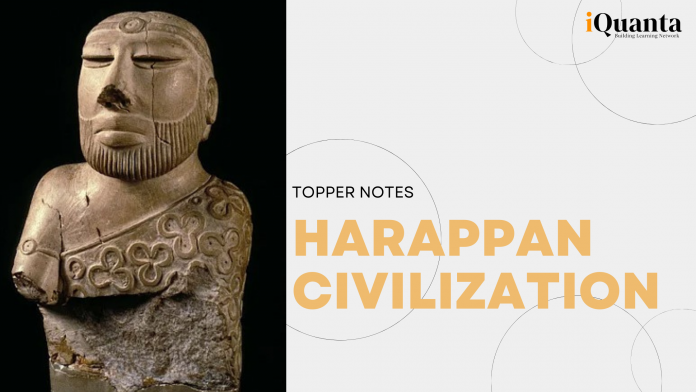Harappan Civilization
- The only acceptable nomenclatures are Harappan civilization and Indus Valley Civilization. Not Saraswati civilization, etc. Contemporary to Mesopotamia.
- Their script is very different, with no matching character
- How did it originate? as a result of the growth of preceding civilizations (like from the Stone age to the chalcolithic age)
- Why non-Harappan civilization couldn’t develop as such? not able to produce a surplus, therefore, unable to carry out trade
- It was of indigenous origin
- Able to prosper because of cultivation techniques (plough irrigation, garbandh [dam to divert water], reservoir): the terracotta model of plough found at Banawali, crossfield found at Kalibangan.
Developed in Three Stages
- Early (3,500-2,600 BC)
- Mature (2,600-1,900 BC)
- Late (1,900 – 1,400 BC)
Were Aryans responsible for their decline?
- Against:
Wheeler: Aryans came from Central Asia, IVC was at North-West, engaged in a fight + their earliest text of Rigveda worshipped a war-god who was known as ‘Purandra’ (destroyer of towns)
- For:
Aryans never invaded India. They came in groups in waves.
How did Mohenjodaro Decline? Possible reasons
- Floods: flooding evidence is present but this can’t be representative as there is no such evidence in other towns
- Epidemic: no evidence of the large-scale epidemic
- Tectonic factor:
– Earthquake led to change in course of river Saraswati
– Many towns of the Harappan civilization were around this river
– Migration and fragmentation led to the dying out of the civilization
Town Architecture
- Upper Town (higher ground; presence of ‘citadel’)
- Lower Towns
Features:
- Grid System (road cutting at right angles)
- Main roads are thicker, some are thinner
- The main gate on small roads
- Courtyards
- Almost all houses have a bathing place (made of burnt bricks)
- Private toilet
- Wells
- Drainage system (covered with loose bricks)
- Used maximum no. of burnt bricks
- All bricks have similar dimensions (1:1:4)
- The Great Bath: water retention capability, stairs + might have been used for rituals
Important Cities of IVC
- Mohenjodaro
– Seals (important: Pashupati seal)
– Bronze sculpture of ‘dancing girl’
– The stone sculpture of the bearded man
– Evidence of cotton
– Great Bath
– Great granary (biggest structure in Mohenjodaro)
– The maximum no. of wells - Harappa
– Barrack-like structure near granary (could be workers quarters for rest)
– Coffin burial - Kalibangan
– Double cropping - Dholavira
– Only town to be divided into three parts
– Evidence of a reservoir (could be for water management)
– Stadium (ground with steps around) - Lothal
– Dockyard
– Found Persial seal
– Centre for bead making - Sanauli
– Grave of a warrior has been found (helmet + sword + chariot)
– Some say the warrior belonged to post-Harappan phase as the Harappans were peaceful
Harappan Burial System
- Most common: extended burial
– person buried in the pit on their back
– North-South orientation - Symbolic burial: Kalibangan
– buried with a pot, where personal items were kept
– belief in the afterlife? - Lothal’s twin burial
- No evidence of cremation has been found. (could happen)
Harappan Life
- Political: divided State, ruled by the different mercantile class
- Social: maintained by different specialised groups (masons/traders/peasants/transporters)
- Economic inequality was present: some houses were large, some small
- Items excavated: bangles & anklets, terracotta female figurines, a copper mirror, etc.
- Were Harappans secular? no evidence of conflict b/w traditions followed many traditions
- Worshipped mother goddess
- Pashupati seal has been found
- They worshipped trees and animals
- Ritual bathing
Economic Life
- Agriculture:
– crops known: wheat, rice, millet, barley, rice and cotton; led very healthy lives, no evidence of malnourishment - Trade: maximum trade was with Mesopotamia (called Harappas ‘Meluha’): Harappan seals found in Mesopotamia
– Gold: Central Asia
– Tin (important for Bronze): Afghanistan
– Semi-precious stones: Afghanistan (Lapis Lazuli)
– Silver: Mesopotamia
– Copper: Khetri mines (Rajasthan)
Harappan Art & Crafts
One of the special features of IVC was well-organised and highly specialized art & crafts. Harappan artists made beautiful objects using different kinds of materials using metal, stone, terracotta, ivory, sea shells
They used gold and silver largely for jewellery. Copper was used for arrowheads and axes. Bronze being the most important metal used in sculptures, with ‘dancing girl’ (Mohenjodaro) being an example. The sculptures were using ‘lost was technique’ (India was the first to use this method.
They also had knowledge of alloys. Most Bronze articles were found in Daimabad.
Harappans were also familiar with drilling tech, as witnessed from their beads making technique.
Seals were made of steatite (soft stone), using integlio technique. The most common animal represented was unicorn (humpless bull). The animals not represented were cow, camel, lion and horse.
Terracotta pottery was also widespread. Many terracotta articles were found like perforated jars, conical jars, terracotta peacock, etc.
Harappan Script
- Script not yet deciphered
- 400 letters (therefor, speculated that they were difficult to be alphabetic unlike English + also could not be pictographic because too few letters to be pictographic, Chinese pictographic script had 2,000 pictures)
- Therefore, the script could be logo-syllabic
- Direction of writing: right to left

